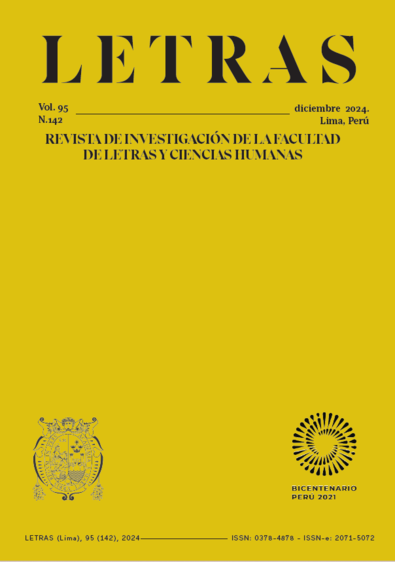La variación fonética en el quechua boliviano sureno: la lenición dorsal y la elisión vocálica
Abstract
This article presents a description of two areas of phonetic variation in South Bolivia Quechua, through the analysis of six interviews with bilingual Quechua-Spanish speakers. The first study describes variable lenition in plain and aspirated dorsal stops k q kh qh (e.g., the pronounciation of paykuna ‘they’ as [pajkuna] or [pajɣuna]), and shows that lenition of q is frequent and general while lenition of k kh and qh is more restricted. Lenition of k is found only in a single phonetic context and lenition of kh is found in only a single root, mikhu- ‘to eat’, in the productions of a few speakers. Lenition of qh is general, but less frequent than lenition of q. The second study presents a quantitative analysis of word-final vowel deletion (e.g., chaypi ‘there’ can be pronounced as [ʧajpi] or [ʧajp]), and shows that deletion is more frequent in phrase-final position and in the context of voiceless consonants. It is noted throughout the presentation that variation is structured, in that the production of a sound varies systematically according to phonetic context, morpheme and/or speaker. The novel contribution of this work to the study of Quechua languages is a more complete description of dorsal consonant lenition and the first description of vowel deletion in this dialect, based on a phonetic analysis of recorded natural speech.Downloads
Métricas alternativas
References
Adelaar, W. y Muysken, P. (2004). The languages of the Andes. Cambridge University Press.
Albó, X. (1964). El quechua a su alcance (2 vols.). Alianza para el Progreso.
Albó, X. (1970). Social Constraints on Cochabamba Quechua. Cornell University.
Bates, D., Maechler, M., Bolker, B. y Walker, S. (2014). lme4: Linear mixed-effects models using Eigen and S4. R package version 1.1-7. http://CRAN.R-project.org/package=lme4
Bills, G., Troike, R. C. y Vallejo, B. (1971). An Introduction to Spoken Bolivian Quechua. University of Texas Press.
Boersma, P. y Weenink, D. (2021). Praat: Doing phonetics by computer. Version 6.1.53. https://www.fon.hum.uva.nl/praat/
Buchholz, T. (2024). Intonation between phrasing and accent: Spanish and Quechua in Huari. De Gruyter.
Camacho Rios, G. (2023). Verbal complexity in South Bolivian Quechua: insights from the speech of monolingual elders. (Tesis doctoral, University of Texas at Austin). http://dx.doi.org/10.26153/tsw/45292
Carbajal Solís, V. C. (2004). Determinación de la frontera dialectal del quechua ayacuchano y cuzqueño en el departamento de Apurímac. (Tesis de licenciatura en Lingüística), Universidad Nacional Mayor de San Marcos. https://cybertesis.unmsm.edu.pe/item/bd92fb63-6d85-4a33-9fb4-310fd-9b3380a
Cerrón-Palomino, R. (1987). Lingüística Quechua. Centro de Estudios Regionales Andinos Bartolomé de Las Casas.
Cohen-Priva, U. (2017). Informativity and the actuation of lenition. Language, 93(3), 569-597. https://doi.org/10.1353/lan.2017.0037
Delforge, A. M. (2011). Vowel devoicing in Cusco Collao Quechua. En W.-S. Lee y E. Zee (Eds.), Proceedings of the 17th Congress of Phonetic Sciences (pp. 556-559). University of Hong Kong.
Floyd, S. (2021). Oclusivas complejas en el quechua de Domingo de Santo Tomás. Letras (Lima), 92(136), 115-140. https://doi.org/10.30920/letras.92.136.10
Gallagher, G. (2016). Vowel height allophony and dorsal place contrasts in Cochabamba Quechua. Phonetica, 73, 101-119. https://doi.org/10.1159/000443651
Gallagher, G. (2022). The phonetic realization of the plain uvular /q/ in a variety of South Bolivian Quechua. Journal of the International Phonetic Association, 53(3), 869- 887. https://doi.org/10.1017/S0025100322000135
Guion, S. G. (2003). The vowel systems of Quichua-Spanish bilinguals. Phonetica, 60(2), 98-128. https://doi.org/10.1159/000071449
Gurevich, N. (2011). Lenition. En V. Oostendorp, C. Ewen, E. Hume y K. Rice (Eds.), The Blackwell companion to phonology (pp. 1559-1575). Blackwell.
Hintz, D. M. (2006). Stress in South Conchucos Quechua: A phonetic and phonological study. International Journal of American Linguistics, 72(4), 477-521. https://doi.org/10.1086/513058
Holliday, N. y Martin, S. (2017). Vowel categories and allophonic lowering among Bolivian Quechua-Spanish bilinguals. Journal of the International Phonetic Association, 48(2), 199-222. https://doi.org/10.1017/S0025100317000512
Huayhua, M. (2018). Labeling and linguistic discrimination. En L. Seligmann y K. Fine-Dare (Coords.), The Andean World (pp. 418-435). Routledge.
Kalt, S. E. y Geary, J. A. (2021). Typological shift in bilinguals’ L1: Word order and case marking in two varieties of child Quechua. Languages, 6(1), 42. https://doi.org/10.3390/languages6010042
Katz, J. (2016). Lenition, perception, and neutralisation. Phonology, 33(1), 43- 85. https://doi.org/10.1017/S0952675716000038
Katz, J. (2021). Intervocalic lenition is not phonological: evidence from Campidanese Sardinian. Phonology, 38, 651-692. https://doi.org/10.1017/S095267572100035X
Lastra, Y. (1965). Fonemas segmentales del quechua de Cochabamba. Thesaurus: boletín del Instituto Caro y Cuervo, 20(1), 48-67.
Labov, W. (2020). The regularity of regular sound change. Language, 96(1), 42- 59. https://doi.org/10.1353/lan.2020.0001
Pierrard, A. (2018). Dialectologie sociale quechua: Approche variationnelle du résau dialectal sud bolivien [Quechua social dialectology: A variationist approach to the South Bolivian Quechua dialect network]. (Tesis doctoral), Université Sorbonne Nouvelle - Paris 3.
Pierrard, A. (2020). Approche diasystémique des phénomènes de voisement en quechua bolivian méridional. Verbum, 42(1-2), 155-176.
Povilonis de Vilchez, N. (2021). Beyond the monolith: Unmasking sociolinguistic variation in Chanka Quechua. (Tesis doctoral). New York University.
R Core Team. (2021). R: A language and environment for statistical computing. R Foundation for Statistical Computing, Vienna, Austria. Version 4.1.1. https://www.R-project.org/
Torero, A. (1983). La familia lingüística quechua. En B. Pottier (Ed.), América Latina en sus lenguas indígenas (pp. 61-92). Monte Ávila Editores.
Valenzuela Bismarck, P. (1995). Realización de la consonante oclusiva postvelar /q/ en el quechua del sur andino. Lexis, 19(2), 289-302. https://doi.org/10.18800/lexis.199502.002
Copyright (c) 2024 Letras (Lima)

This work is licensed under a Creative Commons Attribution 4.0 International License.
Este obra está bajo una licencia de Creative Commons Reconocimiento 4.0 Internacional



















